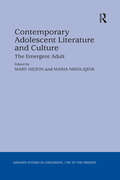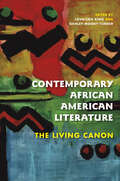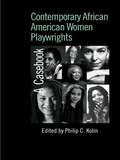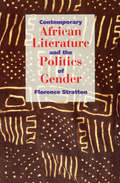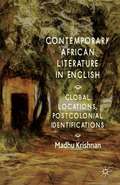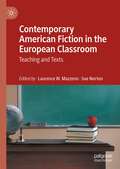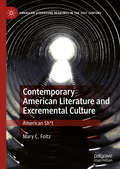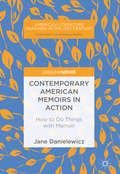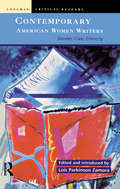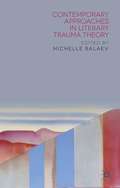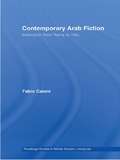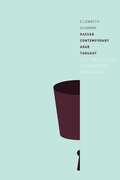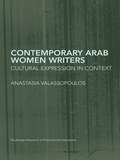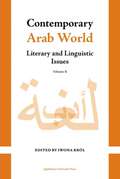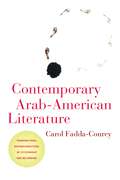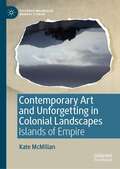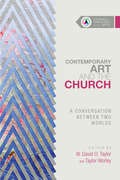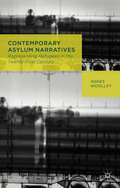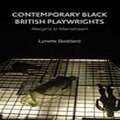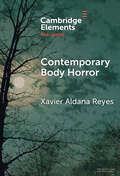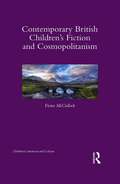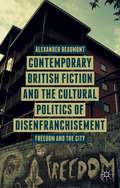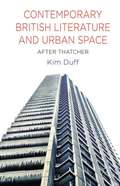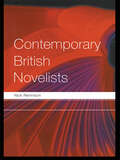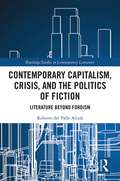- Table View
- List View
Contemporary Adolescent Literature and Culture: The Emergent Adult (Studies in Childhood, 1700 to the Present)
by Mary Hilton Maria NikolajevaOffering a wide range of critical perspectives, this volume explores the moral, ideological and literary landscapes in fiction and other cultural productions aimed at young adults. Topics examined are adolescence and the natural world, nationhood and identity, the mapping of sexual awakening onto postcolonial awareness, hybridity and trans-racial romance, transgressive sexuality, the sexually abused adolescent body, music as a code for identity formation, representations of adolescent emotion, and what neuroscience research tells us about young adult readers, writers, and young artists. Throughout, the volume explores the ways writers configure their adolescent protagonists as awkward, alienated, rebellious and unhappy, so that the figure of the young adult becomes a symbol of wider political and societal concerns. Examining in depth significant contemporary novels, including those by Julia Alvarez, Stephenie Meyer, Tamora Pierce, Malorie Blackman and Meg Rosoff, among others, Contemporary Adolescent Literature and Culture illuminates the ways in which the cultural constructions 'adolescent' and 'young adult fiction' share some of society's most painful anxieties and contradictions.
Contemporary African American Literature: The Living Canon (Blacks in the Diaspora)
by Lovalerie King and Shirley Moody-TurnerEssays exploring contemporary black fiction and examining important issues in current African American literary studies.In this volume, Lovalerie King and Shirley Moody-Turner have compiled a collection of essays that offer access to some of the most innovative contemporary black fiction while addressing important issues in current African American literary studies. Distinguished scholars Houston Baker, Trudier Harris, Darryl Dickson-Carr, and Maryemma Graham join writers and younger scholars to explore the work of Toni Morrison, Edward P. Jones, Trey Ellis, Paul Beatty, Mat Johnson, Kyle Baker, Danzy Senna, Nikki Turner, and many others. The collection is bracketed by a foreword by novelist and graphic artist Mat Johnson, one of the most exciting and innovative contemporary African American writers, and an afterword by Alice Randall, author of the controversial parody The Wind Done Gone. Together, King and Moody-Turner make the case that diversity, innovation, and canon expansion are essential to maintaining the vitality of African American literary studies.“A compelling collection of essays on the ongoing relevance of African American literature to our collective understanding of American history, society, and culture. Featuring a wide array of writers from all corners of the literary academy, the book will have national appeal and offer strategies for teaching African American literature in colleges and universities across the country.” —Gene Jarrett, Boston University“[This book describes] a fruitful tension that brings scholars of major reputation together with newly emerging critics to explore the full range of literary activities that have flourished in the post-Civil Rights era. Notable are such popular influences as hip-hop music and Oprah Winfrey’s Book Club.” —American Literary Scholarship, 2013
Contemporary African American Women Playwrights: A Casebook (Casebooks on Modern Dramatists)
by Philip C. Kolin'The impressive array of scholars gathered in this collection, all experts in the field, read the plays with nuance and situate them deftly within their cultural and historical contexts. Scholars of contemporary theater and drama and of African American literature will find value in this engaging collection.' – Choice 'For students and scholars of American theatre and drama generally and African American theatre and drama most particularly, this is an extremely valuable critical source.' – Harry Elam, Stanford University, USA In the last fifty years, American and World theatre has been challenged and enriched by the rise to prominence of numerous female African American dramatists. Contemporary African American Women Playwrights is the first critical volume to explore the contexts and influences of these writers, and their exploration of black history and identity through a wealth of diverse, courageous and visionary dramas. Kolin compiles a wealth of new essays, comprising: Yale scholar David Krasner on the dramatic legacy of Lorraine Hansberry, Zora Neale Hurston, Marita Bonner and Georgia Douglas Johnson individual chapters devoted to: Alice Childress, Sonia Sanchez, Adrienne Kennedy, Ntozake Shange, Pearl Cleage, Aishah Rahman, Glenda Dickerson, Anna Deavere Smith and Suzan Lori-Parks an essay and accompanying interview with Lynn Nottage comprehensive discussion of attendant theatrical forms, from choreopoems and surrealistic plays, to documentary theatre and civil rights dramas, and their use in challenging racial and gender hierarchies. Contributors: Brandi Wilkins Catanese, Soyica Diggs, James Fisher, Freda Scott Giles, Joan Wylie Hall, Philip C. Kolin, David Krasner, Sandra G. Shannon, Debby Thompson, Beth Turner and Jacqueline Wood.
Contemporary African Literature and the Politics of Gender
by Florence StrattonThe influence of colonialism and race on the development of African literature has been the subject of a number of studies. The effect of patriarchy and gender, however, and indeed the contributions of African women, have up until now been largely ignored by the critics. Contemporary African Literature and the Politics of Gender is the first extensive account of African literature from a feminist perspective.In this first radical and exciting work Florence Stratton outlines the features of an emerging female tradition in African fiction. A chapter is dedicated to each to the works of four women writers: Grace Ogot, Flora Nwapa, Buchi Emecheta and Mariama Ba. In addition she provides challenging new readings of canonical male authors such as Chinua Achebe, Ngugi wa Thiongo'o and Wole Soyinka. Contemporary African Literature and the Politics of Gender thus provides the first truly comprehensive definition of the current literary tradition in Africa.
Contemporary African Literature in English
by Madhu KrishnanContemporary African Literature in English explores the contours of representation in contemporary Anglophone African literature, drawing on a wide range of authors including Chimamanda Ngozi Adichie, Aminatta Forna, Brian Chikwava, Ngug? wa Thiong'o, Nuruddin Farah and Chris Abani.
Contemporary American Fiction in the European Classroom: Teaching and Texts
by Laurence W. Mazzeno Sue NortonThis book offers insight into the ways students enrolled in European classrooms in higher education come to understand American experience through its literary fiction, which for decades has been a key component of English department offerings and American Studies curricula across the continent and in Great Britain and Ireland. The essays provide an understanding of how post-World War II American writers, some already elevated to ‘canonical status’ and some not, are represented in European university classrooms and why they have been chosen for inclusion in coursework. The book will be of interest to scholars and teachers of American literature and American studies, and to students in American literature and American studies courses.
Contemporary American Literature and Excremental Culture: American Sh*t (American Literature Readings in the 21st Century)
by Mary C. FoltzContemporary American Literature and Excremental Culture: American Sh*t analyzes post-1960 scatological novels that utilize representations of human waste to address pressing issues, including pollution of waterways, environmental racism, and militarism. Primarily examining postmodern parody, the book shows the value of aesthetic renderings of sanitary engineering for composting ideologies that fuel a ruinous impact on the world. Drawing on late twentieth-century psychoanalytic thinkers Norman O. Brown, Frantz Fanon, and Leo Bersani, American Sh*t shows the continued relevance of psychoanalytic interpretations of contemporary fiction for understanding post-45 authors’ engagement with waste. Ultimately, the monograph reveals how novelists Ishmael Reed, Jonathan Franzen, Gloria Naylor, Don DeLillo, and Samuel R. Delany critique subjects who abnegate their status as waste-producing beings and bring readers back to embraceWinner of the 2019 Northeast Modern Language Association Book Award for Literary Criticism of English Language Literature
Contemporary American Memoirs in Action: How to Do Things with Memoir (American Literature Readings in the 21st Century)
by Jane DanielewiczThis book analyzes a collection of literary memoirs to demonstrate how this genre is an avenue for participation in public life. Writers are repurposing the memoir, a genre known for its personal and expressive function, to engage in debate and serve political goals. The chapters provide case studies for memoir as social action that effects change by looking at the writing of Joan Didion, John Edgar Wideman, James McBride, M. Elaine Mar, Janisse Ray, Lucy Grealy, and Ann Patchett. Drawing on theories of genre and agency, Danielewicz asserts how these writers are acting pragmatically. Memoirs contribute to democratic society by offering solutions, creating new knowledge, revealing social trends, bringing issues to light, creating empathy and connection, and changing public opinion.
Contemporary American Women Writers: Gender, Class, Ethnicity (Longman Critical Readers)
by Lois Parkinson ZamoraThis collection brings together critical essays that examine questions of identity and community in the fiction of contemporary American women writers among them Alice Walker, Toni Morrison and Sandra Cisnernos. The essays consider how identities and societies are dramatized in particular works of fiction, and how these works reflect cultural communities outside the fictional frame - often the communities in which their authors live and work. The essays included here concern fictional representations of African American, Latino, Asian American, Native American, Anglo and Euro-American communities and their working interactions in the multicultural United States. Each critic asks, in his or her own way, how a particular writer transforms her social grounding into language and literature.The introduction includes an overview of the range of literary criticism devoted to contemporary American women writers, and an extensive bibliography of complementary critical readings is provided to encourage further study. Undergraduate and postgraduate students of contemporary literature will find the text an invaluable guide to contemporary women's writing in America, and the range of criticism that this has given rise to.
Contemporary Approaches in Literary Trauma Theory
by Michelle BalaevThis edited collection argues that trauma in literature must be read through a theoretical pluralism that allows for an understanding of trauma's variable representations that include yet move beyond the concept of trauma as pathological and unspeakable.
Contemporary Arab Fiction: Innovation from Rama to Yalu (Routledge Studies in Middle Eastern Literatures)
by Fabio CaianiThis book introduces Western readers to some of the most significant novels written in Arabic since 1979. Despite their contribution to the development of contemporary Arabic fiction, these authors remain largely unknown to non-Arab readers. Fabio Caiani examines the work of the Moroccan Muhammad Barrada; the Egyptian Idwar al-Kharrat; the Lebanese Ilyas Khuri and the Iraqi Fu’ad al-Takarli. Their most significant novels were published between 1979 and 2002, a period during which their work reached literary maturity. They all represent pioneering literary trends compared to the novelistic form canonized in the influential early works of Naguib Mahfouz. Until now, some of their most innovative works have not been analyzed in detail – this book fills that gap. Relying on literary theory and referring to comparative examples from other literatures, this study places its findings within a wider framework, defining what is meant by innovation in the Arabic novel, and the particular socio-political context in which it appears. This book will significantly enrich the existing critical literature in English on the contemporary Arabic novel.
Contemporary Arab Thought: Cultural Critique in Comparative Perspective
by Elizabeth Suzanne KassabDuring the second half of the twentieth century, the Arab intellectual and political scene polarized between a search for totalizing doctrines—nationalist, Marxist, and religious—and radical critique. Arab thinkers were reacting to the disenchanting experience of postindependence Arab states, as well as to authoritarianism, intolerance, and failed development. They were also responding to successive defeats by Israel, humiliation, and injustice. The first book to take stock of these critical responses, this volume illuminates the relationship between cultural and political critique in the work of major Arab thinkers, and it connects Arab debates on cultural malaise, identity, and authenticity to the postcolonial issues of Latin America and Africa, revealing the shared struggles of different regions and various Arab concerns.
Contemporary Arab Women Writers: Cultural Expression in Context (Routledge Research in Postcolonial Literatures)
by Anastasia ValassopoulosThis book engages with contemporary Arab women writers from Egypt, Palestine, Lebanon and Algeria. In spite of Edward Said’s groundbreaking reappraisal of the uneven relationship between the West and the Arab world in Orientalism, there has been little postcolonial criticism of Arab writing. Anastasia Valassopoulos raises the profile of Arab women writers by examining how they negotiate contexts and experiences that have come to be identified with postcoloniality such as the preoccupation with Western feminism, political conflict and war, the social effects of non-conformity and female empowerment, and the negotiation of influential cultural discourses such as orientalism. Contemporary Arab Women Writers revitalizes theoretical concepts associated with feminism, gender studies and cultural studies, and explores how art history, popular culture, translation studies, psychoanalysis and news media all offer productive ways to associate with Arab women’s writing that work beyond a limiting socio-historical context. Discussing the writings of authors including Ahdaf Soueif, Nawal El Saadawi, Leila Sebbar, Liana Badr and Hanan Al-Shaykh, this book represents a new direction in postcolonial literary criticism that transcends constrictive monothematic approaches.
Contemporary Arab World: Literary and Linguistic Issues, Volume 2 (Contemporary Arab World. Literary and Linguistic Issues)
by Iwona KrólContemporary Arab World: Literary and Linguistic Issues, edited by Iwona Król, is the second volume of the monograph with the same title. It consists of papers written by researchers from the Arabic Department of the Institute of Oriental Studies of the Jagiellonian University in Kraków.The authors, on the base of original texts from broadly understood Arab culture, discuss a number of literary and linguistic issues. Individual chapters are of high academic level, and their subject matters are important from the scientific point of view.Monograph will find readers among specialists from various fields: Arabic and Semitic studies, Polish philology, as well as representatives of literary criticism and general linguistics.
Contemporary Arab-American Literature: Transnational Reconfigurations of Citizenship and Belonging
by Carol Fadda-ConreyThe last couple of decades have witnessed a flourishing of Arab-American literature across multiple genres. Yet, increased interest in this literature is ironically paralleled by a prevalent bias against Arabs and Muslims that portrays their long presence in the US as a recent and unwelcome phenomenon. Spanning the 1990s to the present, Carol Fadda-Conrey takes in the sweep of literary and cultural texts by Arab-American writers in order to understand the ways in which their depictions of Arab homelands, whether actual or imagined, play a crucial role in shaping cultural articulations of US citizenship and belonging. By asserting themselves within a US framework while maintaining connections to their homelands, Arab-Americans contest the blanket representations of themselves as dictated by the US nation-state.Deploying a multidisciplinary framework at the intersection of Middle-Eastern studies, US ethnic studies, and diaspora studies, Fadda-Conrey argues for a transnational discourse that overturns the often rigid affiliations embedded in ethnic labels. Tracing the shifts in transnational perspectives, from the founders of Arab-American literature, like Gibran Kahlil Gibran and Ameen Rihani, to modern writers such as Naomi Shihab Nye, Joseph Geha, Randa Jarrar, and Suheir Hammad, Fadda-Conrey finds that contemporary Arab-American writers depict strong yet complex attachments to the US landscape. She explores how the idea of home is negotiated between immigrant parents and subsequent generations, alongside analyses of texts that work toward fostering more nuanced understandings of Arab and Muslim identities in the wake of post-9/11 anti-Arab sentiments.
Contemporary Art and Unforgetting in Colonial Landscapes: Islands of Empire (Palgrave Macmillan Memory Studies)
by Kate McMillanThis book explores the work of artists based in the global south whose practices and methods interrogate and explore the residue of Empire. In doing so, it highlights the way that contemporary art can assist in the un-forgetting of colonial violence and oppression that has been systemically minimized. The research draws from various fields including memory studies; postcolonial and decolonial strategies of resistance; activism; theories of the global south; the intersection between colonialism and the Anthropocene, as well as practice-led research methodologies in the visual arts. Told through the author’s own perspective as an artist and examining the work of Julie Gough, Yuki Kihara, Megan Cope, Yhonnie Scarce, Lisa Reihana and Karla Dickens, the book develops a number of unique theories for configuring the relationship between art and a troubled past.
Contemporary Art and the Church: A Conversation Between Two Worlds (Studies in Theology and the Arts)
by W. David Taylor Taylor WorleyContemporary Art and the Church
Contemporary Asylum Narratives
by Agnes WoolleyContemporary Asylum Narratives marks a transition from traditional modes of diasporic belonging to the need for identifications that encompass the statelessness of refugees and asylum seekers. This book explores representations of asylum seekers and refugees in twenty-first century literature, film and theatre.
Contemporary Black British Playwrights
by Lynette GoddardThis book examines the socio-political and theatrical conditions that heralded the shift from the margins to the mainstream for black British Writers, through analysis of the social issues portrayed in plays by Kwame Kwei-Armah, debbie tucker green, Roy Williams, and Bola Agbaje.
Contemporary Body Horror (Elements in the Gothic)
by Xavier Aldana Reyes'Body horror', a horror subgenre concerned with transformation, loss of control and the human body's susceptibility to disease, infection and external harm, has moved into the mainstream to become one of the greatest repositories of biopolitical discourse. Put simply, body horror acts out the power flows of modern life, visualising often imperceptible or ignored processes of marginalisation and behavioural policing, and revealing how interrelations between different social spheres (medical, legal, political, educational) produce embodied identity. This book offers the first sustained study of the types of body horror that have been popular in the twenty-first century and centres on the representational and ideological work they carry out. It proposes that, thanks to the progressive vision of feminist, queer and anti-racist practitioners, this important subgenre has expanded its ethical horizons and even found a sense of celebratory liberation in fantastic metamorphoses redolent of contemporary activist movements.
Contemporary British Children's Fiction and Cosmopolitanism (Children's Literature and Culture)
by Fiona McCullochThis book visits contemporary British children’s and young adult (YA) fiction alongside cosmopolitanism, exploring the notion of the nation within the context of globalization, transnationalism and citizenship. By resisting globalization’s dehumanizing conflation, cosmopolitanism offers an ethical, humanitarian, and political outlook of convivial planetary community. In its pedagogical responsibility towards readers who will become future citizens, contemporary children’s and YA fiction seeks to interrogate and dismantle modes of difference and instead provide aspirational models of empathetic world citizenship. McCulloch discusses texts such as J.K. Rowling’s Harry Potter series, Jackie Kay’s Strawgirl, Theresa Breslin’s Divided City, Gillian Cross’s Where I Belong, Kerry Drewery’s A Brighter Fear, Saci Lloyd’s Momentum, and Julie Bertagna’s Exodus trilogy. This book addresses ways in which children’s and YA fiction imagines not only the nation but the world beyond, seeking to disrupt binary divisions through a cosmopolitical outlook. The writers discussed envision British society’s position and role within a global arena of wide-ranging topical issues, including global conflicts, gender, racial politics, ecology, and climate change. Contemporary children’s fiction has matured by depicting characters who face uncertainty just as the world itself experiences an uncertain future of global risks, such as environmental threats and terrorism. The volume will be of significant interest to the fields of children’s literature, YA fiction, contemporary fiction, cosmopolitanism, ecofeminism, gender theory, and British and Scottish literature.
Contemporary British Fiction and the Cultural Politics of Disenfranchisement
by Alexander BeaumontDuring the 1980s, urban space became an important battleground in a confrontation between left and right over the meaning of freedom. While Thatcherism sought to harness the power of the free market to rationalise and reform the inner cities, the response of the 'cultural' left was to celebrate the emancipatory potential of flexible identities and expressive practices associated with urban subcultures. However, through close readings of eight contemporary authors, this book argues that a problematic consequence of the left's experiment with freedom was to elevate exclusion to the status of a political principle and to close down the space of politics itself. It explores how, in less than two decades, the coexistence of flexible cultural identities and urban space has become a virtual impossibility in British fiction. And it suggests that, today, the British novel is frequently marked by structures of failed utopianism, frustrated or incomplete experiments and even withdrawal and quietism, all of which are a consequence of the left's celebration of a cultural politics of disenfranchisement.
Contemporary British Literature and Urban Space
by Kim DuffLooking at writers such as Will Self, Hani Kureishi, JG Ballard, and Iain Sinclair, Kim Duff's new book examines contemporary British literature and its depiction of the city after the time of Thatcher and mass privatization. This lively study is an important and engaging work for students and scholars alike.
Contemporary British Novelists (Routledge Key Guides)
by Nick RennisonFeaturing a broad range of contemporary British novelists from Iain Banks to Jeanette Winterson, Louis de Bernieres to Irvine Welsh and Salman Rushdie, this book offers an excellent introductory guide to the contemporary literary scene. Each entry includes concise biographical information on each of the key novelists and analysis of their major works and themes. Fully cross-referenced and containing extensive guides to further reading, Fifty Contemporary British Novelists is the ideal guide to modern British fiction for both the student and the contemporary fiction buff alike.
Contemporary Capitalism, Crisis, and the Politics of Fiction: Literature Beyond Fordism (Routledge Studies in Contemporary Literature)
by Roberto del Valle AlcaláContemporary Capitalism, Crisis, and the Politics of Fiction: Literature Beyond Fordism proposes a fresh approach to contemporary fictional engagements with the idea of crisis in capitalism and its various social and economic manifestations. The book investigates how late-twentieth and twenty-first-century Anglophone fiction has imagined, interpreted, and in most cases resisted, the collapse of the socio-economic structures built after the Second World War and their replacement with a presumably immaterial order of finance-led economic development. Through a series of detailed readings of the words of authors Martin Amis, Hari Kunzru, Don DeLillo, Zia Haider Rahman, John Lanchester, Paul Murray and Zadie Smith among others, this study sheds light on the embattled and decidedly unstable nature of contemporary capitalism.
